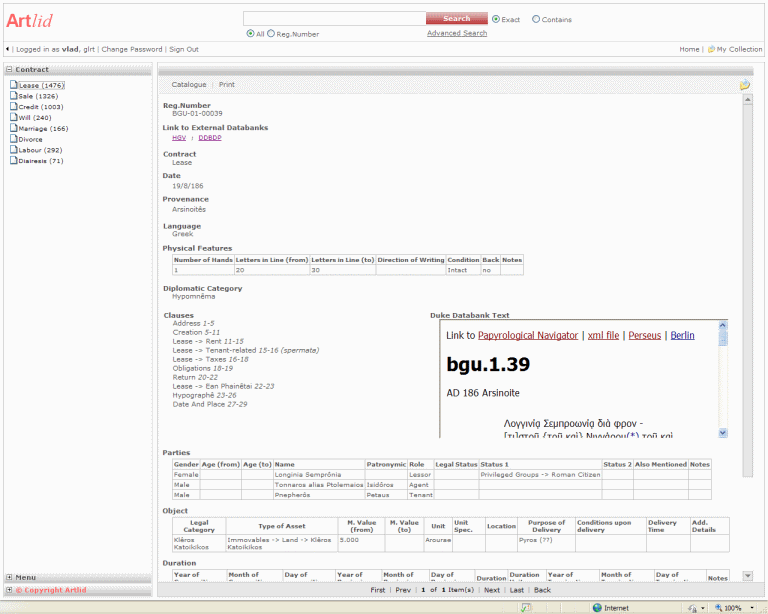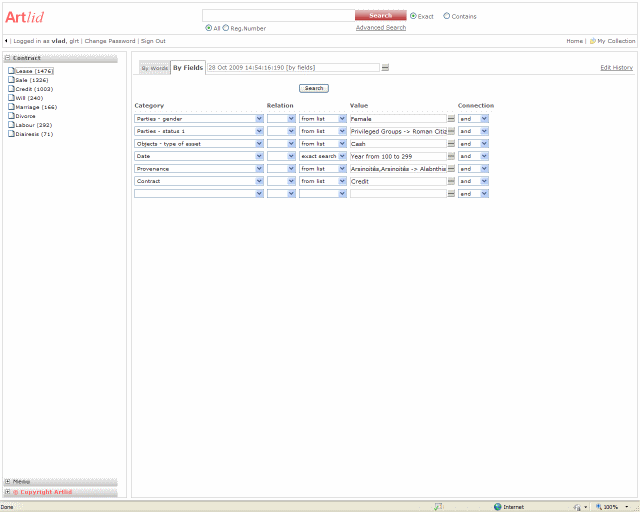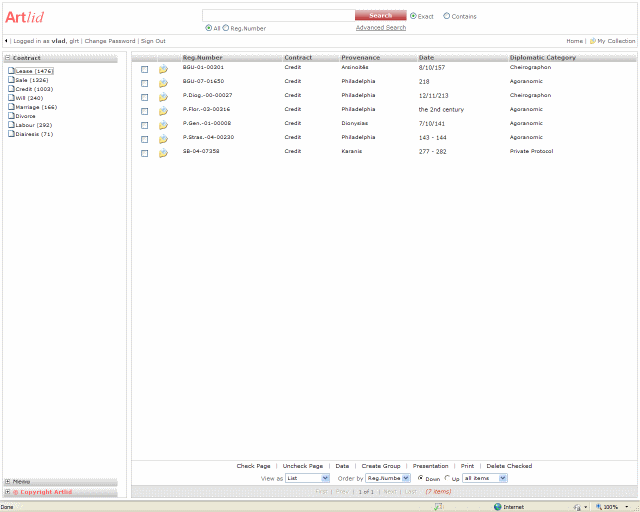GLRT
Overview
Metadata
Advanced Search
Overview:
Welcome to “Greek Law in Roman Times”. This computerized Databank provides electronic access to some 6000 legal documents from Hellenistic, Roman and Byzantine times, mostly from Egypt.
These documents and their classifications provide invaluable information concerning the development of law and legal practices from the Ptolemaic to Byzantine period. It also provides information about social and economic issues, such as the value of land in ancient society, the extent of economic independence of women, the circulation of cash-money, how the parties’ age affected the nature and scope of their economic activity etc. GLRT enables users to pinpoint correlations between the various recorded factors. Thus it provides a critical and heretofore-absent tool that enables scholars to discern patterns among the wealth of documents.
The databank classifies each document by its date and provenance, structure, language and other details regarding the parties to the contract and the content of the transaction. The databank contains a link to the text as it appears in the “Duke Databank of Documentary Papyri” as well as to the “Heidelberger Gesamtverzeichnis”. The DDBDP text can be viewed in a small window to the right of the structural synopsis of the document (i.e., ”Clauses”) or as a separate window by following the direct link provided (‘Link to External Databanks’).
On entering the databank the user will see on the left-hand side a list of contract types; the number of documents present in each category is displayed in parentheses. Following the link will lead the user to a list of contracts. The contracts can be further browsed in order to review their contents. By clicking ‘leases’ and then any item (e.g., BGU-01-00039) the user will access the following information:

Metadata:
Below is a brief account of some of the criteria used in GLRT for classifying legal documents.
Reg. Number: This is the standard designation of the papyrus following the Checklist of Editions found online at http://scriptorium.lib.duke.edu/papyrus/texts/clist_papyri.html.
Contract: General type of contract: Lease, Sale, Credit, Will, Marriage, Divorce, Labour and Diairesis (i.e. division of the family estate among co-heirs).
Contract Specification: Information on contractual sub-categories: within ‘credit’ antichrêsis, paramonê , etc., within ‘sale’ sale on delivery, etc.
Provenance: Recording the contract’s place of composition.
Date: The date may be a specific year, a timeframe, or a century of composition. When searching, years BC are to be indicated by the – (=minus) sign (e.g., -100 indicates 100 BC); years AD are to be left unmarked.
Language: the great majority of the documents are in Greek; some, however, include smaller or greater portions in other languages. The inclusion of monolingual texts in Demotic and Coptic will follow at a later stage.
Physical Features: This category describes the state of preservation of the document, the average number of letters per line, the contents of the back of the text and other relevant details. For a sense of the length of the document please the user can consult the “Clauses” category.
Diplomatic category: Legal documents are written in different formats. Some take the format of a letter (cheirographon), some of an appeal (hypomnêma), while others are formulated as dispute settlements (e.g., synchôrêsis). The type of format used usually points to the scribe who issued it; for example, contracts formulated as letters are mostly written by private, not by state scribes. For the terminology in this section, cf. H.J. Wolff, Das Recht der griechischen papyri Aegyptens in der Zeit der Ptolemaeer und des Prinzipats II: Organization und Kontrolle des privaten Rechtsverkehrs (Munich, 1978).
Link to External Databanks: By entering “Duke Databank of Documentary Papyri” as a separate window the user can follow a link to the “Papyrological Navigator”. There the user will have access to information on the papyrus worldwide, including its picture and translation (if available), and of course to the text itself. The link to the “Heidelberger Gesamtverzeichnis” will allow the user to inspect the picture of the document (if one is available online) and to access www.trismegistos.org.
Clauses: The clauses of the contract report when and where the document was composed, the act that created the contract and its terms – i.e., the formulaic contents of the document. The databank reports the clauses incorporated in each document with their respective lines, and contains a glossary reporting each clause’s spheres and periods of application. Using “clauses” legal historians will gain a quick glimpse of the types of clauses that are commonly incorporated in different contracts and will be able to see how the structure of the contract changed through time and differed by region.
Parties: Information regarding the gender, age, role and identification of the parties to the contract. The identification can relate to the parties’ occupation as stated in the document, their ethnicity, civic affiliation and family ties. This factor allows the user to conduct prosopographic research and to assess the economic standing of ‘special’ groups, such as women, Jews, Roman citizens, slaves etc.
Duration: The duration of the contract, if stated, as is the case in leases, loans or contracts of labor.
Object: The object being bought, sold, borrowed or exchanged. This group of data allows the user to study, for example, what type of land was commonly alienated, and its average size.
Consideration: the remuneration, in cash or kind, and any details pertaining to it (such as a particular weight, unit or standard specified).
Advanced Search:
One of the merits of the databank is its search engine. By clicking “advanced search” at the top of the page the user will access a group of four lines where he or she can enter any search criteria available. Once the user selects a criterion (say, provenance) he should click, in the same line, on the button with three dots just before the word “connection” on the right side of the screen. The user will then access a scroll-down menu. After entering the scroll-down menu the user can select his choice by scrolling down or by entering some of the letters of the village’s name in the small window near the word “find”. For instance, the most convenient way to mark “Tebtynis” is to enter “teb” into the “find” window and mark Tebtynis in the resulting list. The user can naturally select more than one village, nome etc., or specify an entire nome with all its villages.
The number of factors that can be searched by is unlimited. After the user entered the fourth factor a fifth line will appear and so on. The user may look, for example, for example, for women [parties, gender] who are Roman citizens [parties, status], who borrowed cash [contract; object, type of asset], in the second or third century AD in the Arsinoite nome [date, provenance].

The results of such a search would be as follows:
